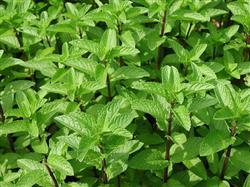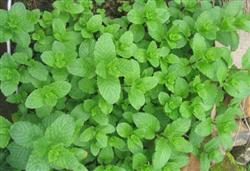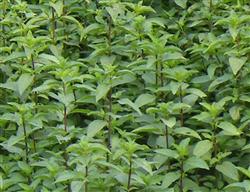High-yield cultivation techniques of peppermint

Mint is one of the main cash crops. The plant is used as a whole grass or as a medicine. It has strong adaptability, like temperature and humid environment, and has strong vitality under dry conditions. After rhizome planting, the seedlings can emerge when the daily average temperature is 6 ℃, and the growth is the fastest from May to June, and the suitable temperature for growth is 20-30 ℃. When the temperature drops below zero, the aboveground part shrinks and dries up, and the growth stops. Peppermint is not strict on soil, clay, old soil, loam and sandy soil can grow. Long, the general soil pH6.5-7.5is the best. First, the farmer proverb "peppermint grows stubble". Select the land which has not planted peppermint for 2-3 years with high dry terrain, convenient drainage and irrigation and fertile soil. 2. Before planting, 60000 kg of rotten organic fertilizer, 750kg of ammonium bicarbonate and 900kg of calcium superphosphate are sprinkled on each hectare, followed by ploughing, then raked and leveled to make a border 1.5m wide for irrigation. Third, propagation methods peppermint can be propagated by seeds, cuttings, ramets and rhizomes. Production is mainly based on rhizome breeding and ramet propagation. Branch propagation is to pull out seedlings and transplant. The field with good growth, no insect and no disease is selected as the seedling transfer field. From April to May, when the seedling height is 10-15 cm, the seedlings can be raised and transplanted. Rhizome propagation. The planting period is from late October to the end of April of the following year, and the planting at the end of autumn is the best. Early planting takes root quickly, sprouts more, and the roots and buds are stout. Before planting, turn up the rhizome and select the white, sturdy, short annual rhizome. The planting row spacing is 25 cm, and the density should be connected to the end of the rhizome. The rhizome can also be cut into small sections 10 cm long, evenly scattered in the ditch, and then covered with soil and raked repeatedly to prevent the bridge from being empty and unsolid, cold wind invading and freezing to death. About 1200-1500 kg of rhizome should be planted per hectare. 4. Field management transplanting mint can emerge in the middle or late of March, check and transplant when the seedling is 10 cm high in early April, get rid of pimple seedlings and keep 30-450000 seedlings per hectare. Ploughing in time after emergence, once every 10 days, 2-3 times in a row. As the soil of mint rhizome is shallow, towel ploughing should be shallow and avoid deep, so as to prevent root injury and stem breakage, affecting growth and yield improvement. During the growth of peppermint, the surface should be kept moist and irrigated in time during drought. It is advisable to irrigate with small water. Heavy rainfall in summer and autumn, it is necessary to eliminate stagnant water in the field to prevent the rhizome from suffocating to death. After the first harvest in August, 300-400 kg of urea was applied per hectare. When the height of the second stubble seedling is about 10 cm, 1.5-20,000 kg of rare human feces are applied per hectare, and weeds in the field are removed. After the second crop harvest, it should be covered with high-quality organic fertilizer to lay the foundation for early growth and rapid growth in the next year. 5. the main diseases and insect pests of peppermint are spot blight, rust and Spodoptera litura. Spot blight should be removed in time, deeply buried or burned outside the mountain field, reduce the source of infection, spray with 120 times Bordeaux solution, or use 65% Dysen zinc 500 times solution foliar spray. Rust should be sprayed with 1000 times of 15% vermicellin wettable powder or 40% carbendazim gel suspension at the initial stage of the disease. The silver liquid moth was sprayed with 1000 times of 90% trichlorfon or 2.5% deltamethrin or 20% fenvalerate 1500 times.
- Prev

Efficient planting technique of peppermint
Peppermint alias Su mint, South peppermint, for the Labiatae plant peppermint, with the whole grass medicine, with the evacuation of wind and heat, clear leader, regulating qi and relieving depression and other effects. Peppermint has strong adaptability and is planted in the area of 300m-1000 m above sea level, and its oil and menthol content is high. Like warm and humid environment, the optimum temperature for growth is 20 ℃.
- Next

Management of mint before and after emergence
According to the practice of large area mint cultivation for many years, strengthening the field management before and after emergence of mint seedlings is an effective measure to achieve high yield, high quality and high efficiency. It can increase the yield of peppermint crude oil by 1.5 kg per mu, with a net profit of about 100 yuan. First, clear the ditch to regulate the moisture and reduce the humidity in the field. Peppermint is afraid of drought and is not resistant to water.
Related
- Fuxing push coffee new agricultural production and marketing class: lack of small-scale processing plants
- Jujube rice field leisure farm deep ploughing Yilan for five years to create a space for organic food and play
- Nongyu Farm-A trial of organic papaya for brave women with advanced technology
- Four points for attention in the prevention and control of diseases and insect pests of edible fungi
- How to add nutrient solution to Edible Fungi
- Is there any good way to control edible fungus mites?
- Open Inoculation Technology of Edible Fungi
- Is there any clever way to use fertilizer for edible fungus in winter?
- What agents are used to kill the pathogens of edible fungi in the mushroom shed?
- Rapid drying of Edible Fungi

